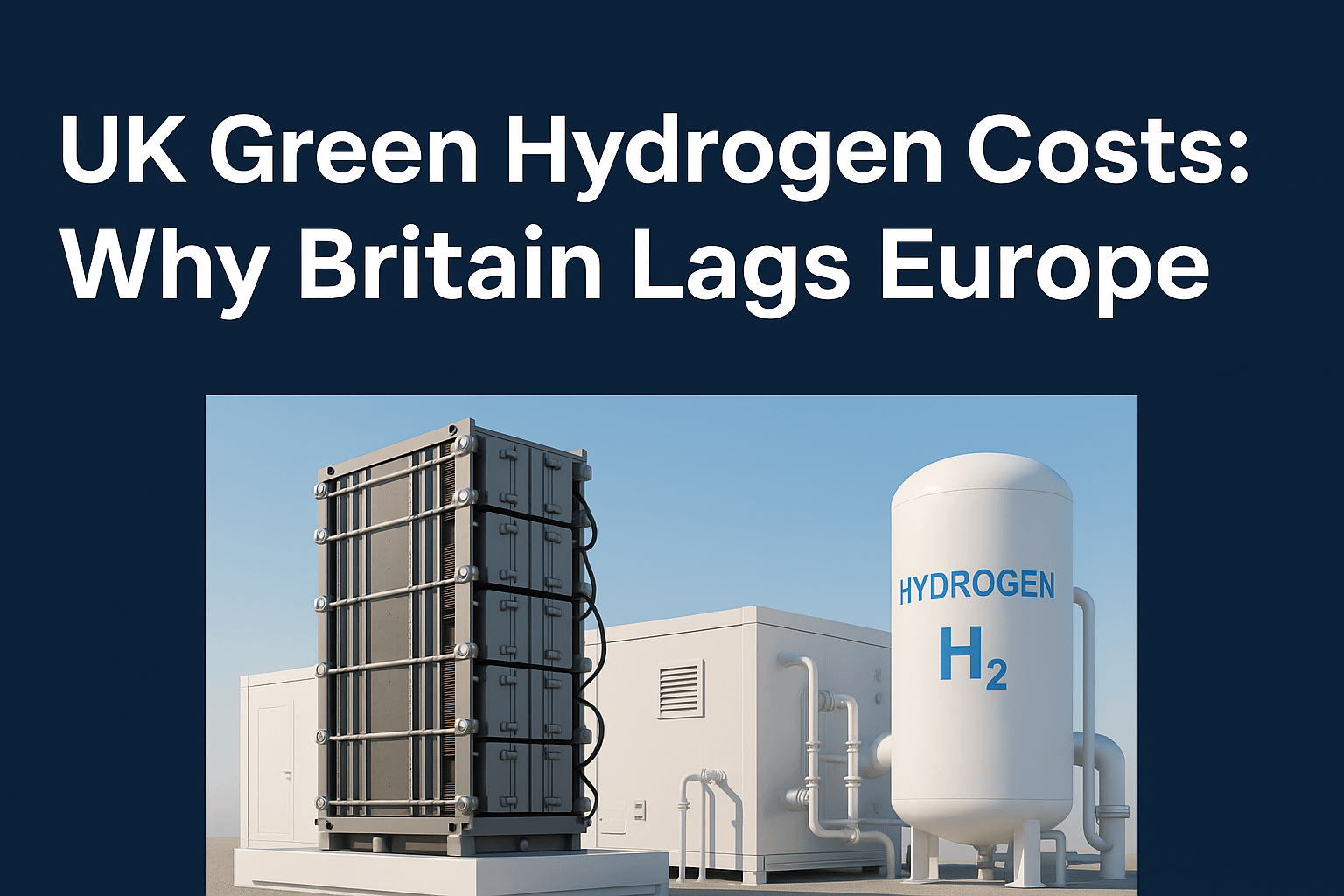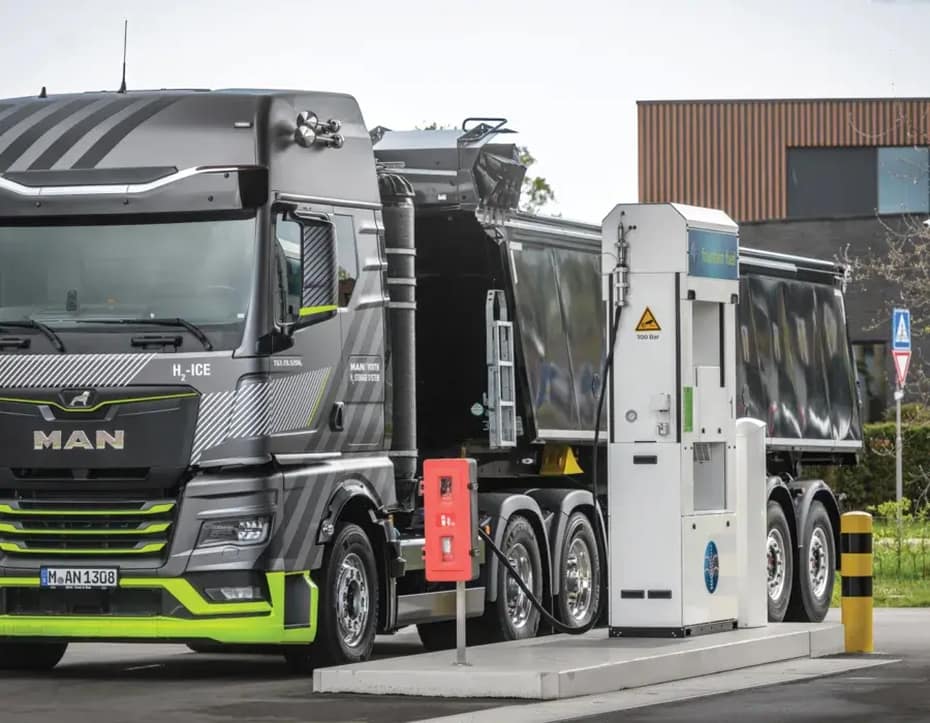UK green hydrogen costs remain among the highest in Europe, limiting market growth despite strong government ambition.
The UK’s green hydrogen story has been one of high ambition, significant public funding, and persistent structural challenges. The goal of 10 GW of low-carbon hydrogen production by 2030 remains central to government strategy, but market uptake has lagged behind expectations. The issue is not technical feasibility—it is commercial viability.
1. The Policy Framework
The Department for Energy Security and Net Zero’s Hydrogen Strategy set out a clear ambition: to create a competitive, scalable hydrogen sector that supports industrial decarbonisation and energy resilience. Trade associations such as RenewableUK and Hydrogen UK have since focused on cost reduction—specifically, reducing production costs from around £241/MWh in early allocation rounds to below £100/MWh. Academic and policy analysis consistently highlights that electricity costs dominate the economics, accounting for roughly 70 percent of total production costs.
To translate those numbers, a typical electrolyser producing hydrogen at 50–55 kWh per kilogram would yield a cost of around £12 per kg at £241/MWh, and roughly £5 per kg at £100/MWh, before adding compression, storage, and distribution. Even at the lower bound, this remains significantly above the cost of grey hydrogen from natural gas, typically £1–2 per kg. In short, UK green hydrogen costs are tightly linked to input electricity prices and plant utilisation.
2. The Cost Structure of UK green hydrogen costs
Green hydrogen’s main cost driver is the electricity used in electrolysis. Where renewables are expensive or intermittent, hydrogen production becomes uneconomic. Across Europe, renewable-based hydrogen costs typically range from €4 to €17 per kilogram, depending on electricity price, plant utilisation, and scale. In the UK, high industrial electricity costs and relatively low plant load factors make competitiveness particularly difficult.
Even where wind or solar energy is nominally cheap, conversion losses and infrastructure costs add complexity. A plant using curtailed wind, for example, will operate at a low utilisation rate and therefore a higher cost per unit of hydrogen produced. This is why the £/MWh → £/kg translation is essential when discussing UK green hydrogen costs.
3. The Demand Challenge
The limited customer base for green hydrogen is often attributed to its price. However, cost is only part of the explanation. The wider issue is that hydrogen has been positioned as a universal energy solution when, in reality, it is a niche fuel suited to specific applications—industrial heat, chemical feedstocks, long-haul transport—where direct electrification is not practical.
Buyers in these sectors need long-term certainty on price, supply, and infrastructure. Without that, hydrogen projects remain speculative. Furthermore, the UK’s relatively high power prices make it difficult to offer hydrogen at globally competitive rates, particularly against blue hydrogen derived from natural gas with carbon capture. For more context on pricing and utilisation trade-offs, see our related note on hydrogen and data centres.
4. Opportunities for Progress
Despite the current challenges, there are reasons to remain cautiously optimistic. Several cost-reduction levers are already in motion:
- Electrolyser efficiency is improving, with capital costs expected to fall as manufacturing scales.
- Renewable-hydrogen co-location can improve utilisation and grid balancing.
- Targeting industrial clusters where hydrogen replaces existing fossil inputs can create bankable demand.
Hydrogen UK projects that a mature hydrogen economy could support 30,000 jobs and £7 billion of annual GVA by 2030, provided the cost base narrows and customer demand strengthens.
5. Closing the Gap
For green hydrogen to progress from pilot phase to mainstream deployment, three conditions must be met:
- Lower electricity input costs – through market reform or strategic co-location with low-cost renewable generation.
- Higher plant utilisation – enabled by flexible operation and better integration with the grid.
- Defined industrial offtakes – ensuring early projects are tied to end-users that genuinely need hydrogen, rather than speculative markets.
6. Lessons for Policy and Industry on UK green hydrogen costs
Early policy thinking often assumed that the falling cost of renewable power would automatically make hydrogen competitive. In practice, conversion, compression, storage, and distribution costs remain significant. The expectation that demand would materialise once production began has also proved optimistic. Buyers will only commit when the economics and infrastructure make long-term sense.
Subsidies can accelerate investment but cannot indefinitely compensate for a structural cost disadvantage. The focus now must shift from headline targets to practical integration—ensuring hydrogen is used where it delivers measurable decarbonisation and value.
7. The Outlook
The lack of customers for green hydrogen in the UK reflects both price and positioning. It is not yet cost-competitive, and it has been promoted too broadly. Its future lies in focused industrial applications, supported by lower power costs, stable policy, and credible offtake agreements.
At present cost levels, green hydrogen will remain a premium product—viable where substitution of fossil fuels is mandated or incentivised, but unlikely to scale without systemic cost reductions. The opportunity remains significant, but bridging the gap between technical capability and commercial reality will determine whether hydrogen becomes a core pillar of the UK’s energy transition or another promising technology stranded by economics.
8. Will the UK Follow Europe’s Lead?
The UK’s high industrial electricity costs are not a global inevitability; they are a domestic policy outcome. In Europe, several governments have already moved to protect electro-intensive industries, including hydrogen producers, from volatile power prices through contracts for difference, grid fee exemptions, or direct subsidies for renewable power supply.
- Germany has introduced Power Purchase Agreements for Hydrogen linking producers directly to low-cost renewable generation and has set aside €3.6 billion for H₂ production support under the H2Global mechanism.
- The Netherlands offers full exemption from energy taxes for electricity used in electrolysis, effectively lowering input cost by up to 20%.
- Spain and Portugal leverage low wholesale power prices and co-located renewables to drive production costs below €3/kg.
By contrast, the UK’s electricity pricing model still treats electrolysis as a standard industrial load, facing grid levies, balancing costs, and wholesale exposure. Unless this structure changes, UK green hydrogen costs will remain 30–50 percent higher than continental production—undermining competitiveness domestically and for export.
There are signs of policy movement: the recent Hydrogen Production Business Model (HPBM) includes revenue support through difference payments, but this alone cannot offset structural input cost disparities.
The likely trajectory is alignment with European practice. If UK industry faces imported green ammonia or steel made with cheaper European hydrogen, domestic producers will require parity mechanisms simply to stay viable.
In other words, the UK can lead on ambition or follow on policy. The economics will decide which.


